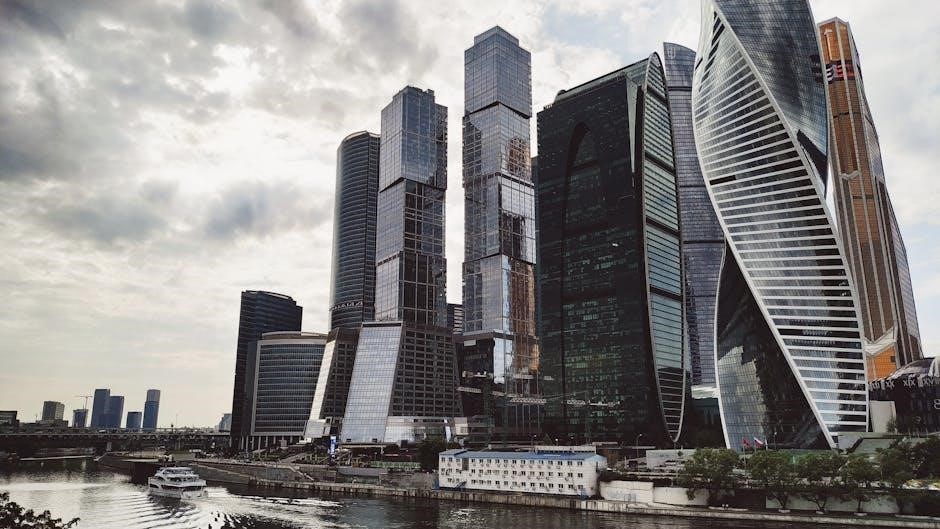
The International Building Code establishes minimum requirements for building systems using provisions, it is founded on broad-based principles, making possible the use of new materials and designs, as stated on the official website.
Overview of the International Building Code
The International Building Code is a model code that establishes minimum requirements for building systems using prescriptive and performance-related provisions. It is founded on broad-based principles that make possible the use of new materials and new building designs. The code is designed to protect public health and safety by establishing minimum requirements for building systems, including structural, fire-resistance, and accessibility features. The International Building Code is used as a basis for building codes in many countries, including the United States, and is regularly updated to reflect changes in building technology and safety standards. The code is published by the International Code Council, a nonprofit organization that develops and maintains model codes and standards for the built environment. The International Building Code is an important tool for building officials, architects, engineers, and contractors, as it provides a comprehensive set of requirements for building design and construction.
History of the International Code Council

The International Code Council was founded in 1994 through the merger of three regional model code organizations in the American construction industry. The organization was established to develop and maintain model codes and standards for the built environment, with the goal of protecting public health and safety. The International Code Council is a nonprofit organization that is sponsored by the building trades, and its members include building officials, architects, engineers, and contractors. The organization has its headquarters in Washington, D.C. and has been located at Capitol Crossing since 2023. The International Code Council has a long history of developing and promoting model codes and standards, and its codes are widely used in the United States and around the world. The organization is committed to providing high-quality codes and standards that reflect the latest advances in building technology and safety standards, and it regularly updates its codes to reflect changes in the industry. The International Code Council plays a critical role in promoting public health and safety through its work on model codes and standards.

Scope of the International Building Code
The code applies to most buildings, with certain exceptions, as outlined on the official website of the International Code Council, in accordance with regulations.
Buildings Covered by the IBC
The International Building Code applies to a wide range of buildings, including commercial, industrial, and residential structures, as stated on the official website of the International Code Council.
The code covers most buildings, with certain exceptions, such as detached one- and two-family dwellings and townhouses up to three stories.
The IBC also applies to buildings that are occupied for residential, commercial, or industrial purposes, and includes requirements for building design, construction, and occupancy.
The code is intended to ensure that buildings are safe, accessible, and energy efficient, and that they comply with minimum standards for building systems, including structural, mechanical, and electrical systems.
The IBC is used by building officials, architects, engineers, and contractors to ensure that buildings are designed and constructed in accordance with the code’s requirements.
The code is regularly updated to reflect changes in building technology, materials, and design practices, and to address emerging issues such as sustainability and energy efficiency.
Exemptions and Special Cases
The International Building Code provides exemptions and special cases for certain types of buildings and structures, including agricultural buildings, temporary structures, and historic buildings.
These exemptions and special cases are outlined in the code and are intended to balance the need for safety and accessibility with the need for flexibility and practicality.
The code also includes provisions for alternative materials and methods, which can be used in place of traditional materials and methods.
In addition, the code provides for special inspections and testing, which can be required for certain types of buildings and structures.
The exemptions and special cases are intended to ensure that the code is fair and reasonable, and that it does not impose undue burdens on building owners and designers;
The code is regularly updated to reflect changes in building technology and design practices, and to address emerging issues and concerns.
Overall, the exemptions and special cases in the International Building Code are an important part of the code’s overall framework, and help to ensure that the code is effective and practical.

IBC PDF Resources
Official IBC PDF documents are available for download from the International Code Council website for reference and use.
Availability of IBC PDF Documents
The International Code Council provides access to IBC PDF documents through their official website, allowing users to download and reference the codes. The website offers a range of documents, including the International Building Code, International Residential Code, and International Energy Conservation Code, among others. These documents are available in PDF format, making it easy for users to access and print the information they need. The website also provides a search function, allowing users to quickly find specific codes and documents. Additionally, the International Code Council offers a subscription service, which provides users with access to the latest versions of the codes, as well as updates and revisions. This service is particularly useful for professionals who need to stay up-to-date with the latest codes and regulations. Overall, the availability of IBC PDF documents through the International Code Council website makes it easy for users to access the information they need.
Types of IBC PDF Documents
The International Code Council offers a variety of IBC PDF documents, including code books, commentaries, and reference materials. These documents provide detailed information on building codes, regulations, and standards, and are available for download from the International Code Council website. The code books provide the actual code text, while the commentaries offer explanations and examples to help users understand the code requirements. Reference materials, such as the International Building Code Handbook, provide additional information and resources to support the use of the code. The International Code Council also offers PDF documents specifically focused on certain topics, such as energy efficiency, accessibility, and seismic design. These specialized documents provide in-depth information on specific aspects of building design and construction, and are useful for professionals working in these areas. Overall, the range of IBC PDF documents available from the International Code Council provides users with a comprehensive set of resources to support their work.

Standards and Certification
Establishing minimum requirements for building systems using provisions and codes as stated on the official website for standards and certification purposes only always.
Conformance to Standards
The International Building Code provides guidelines for conformance to standards, which is crucial for ensuring building safety and compliance with regulations. The code outlines specific requirements for various aspects of building design and construction, including structural integrity, fire resistance, and accessibility. Conformance to the IBC standards is typically verified through a process of plan review and inspection, which involves reviewing building plans and conducting on-site inspections to ensure that the building meets the code requirements. The IBC also provides a framework for certification, which involves verifying that a building or product meets specific standards or criteria. This certification process can be performed by independent third-party organizations or by government agencies, depending on the jurisdiction. By conforming to the IBC standards, building owners and designers can ensure that their buildings are safe, durable, and compliant with relevant regulations, which can help to reduce the risk of accidents, injuries, and property damage. The IBC standards are widely adopted and recognized, making it easier to ensure conformance and compliance across different jurisdictions and regions. Overall, conformance to the IBC standards is an essential aspect of building design and construction, and it plays a critical role in ensuring public safety and protecting property. The code is regularly updated to reflect changes in technology, materials, and design practices, which helps to ensure that buildings remain safe and compliant over time. By following the IBC standards and guidelines, builders and designers can create buildings that are not only safe and durable but also sustainable and environmentally friendly; This can help to reduce the environmental impact of buildings and promote more sustainable development practices. The IBC standards also provide a framework for addressing specific building-related issues, such as seismic design and energy efficiency, which can help to reduce the risk of damage and injury from natural disasters and other hazards. Additionally, the IBC standards can help to promote consistency and uniformity in building design and construction, which can make it easier to compare and evaluate different buildings and designs. This can be particularly useful for builders, designers, and regulators who need to ensure that buildings meet specific standards and criteria. Furthermore, the IBC standards can help to support innovation and technological advancement in the building industry, by providing a framework for testing and evaluating new materials and design practices. This can help to drive innovation and improvement in building design and construction, which can lead to safer, more sustainable, and more efficient buildings. The IBC standards are also widely recognized and respected, which can help to promote international cooperation and collaboration in the building industry. This can facilitate the exchange of ideas, technologies, and best practices, which can help to drive progress and improvement in building design and construction. Overall, conformance to the IBC standards is essential for ensuring building safety, compliance, and sustainability, and it plays a critical role in promoting innovation, consistency, and uniformity in the building industry. The IBC standards provide a comprehensive framework for building design and construction, which can help to reduce the risk of accidents, injuries, and property damage, while also promoting more sustainable and environmentally friendly buildings. The code is widely adopted and recognized, and it provides a basis for certification, inspection, and testing, which can help to ensure that buildings meet specific standards and criteria. By following the IBC standards and guidelines, builders and designers can create buildings that are safe, durable, and compliant with relevant regulations, which can help to promote public safety and protect property. The IBC standards are regularly updated to reflect changes in technology, materials, and design practices, which helps to ensure that buildings remain safe and compliant over time. This can help to reduce the risk of damage and injury from natural disasters and other hazards, while also promoting more sustainable and environmentally friendly buildings. The IBC standards provide a framework for addressing specific building-related issues, such as seismic design and energy efficiency, which can help to reduce the risk of damage and injury from natural disasters and other hazards. Additionally, the IBC standards can help to promote consistency and uniformity in building design and construction, which can make it easier to compare and evaluate different buildings and designs. This can be particularly useful for builders, designers, and regulators who need to ensure that buildings meet specific standards and criteria. The IBC standards are widely recognized and respected, which can help to promote international cooperation and collaboration in the building industry. This can facilitate the exchange of ideas, technologies, and best practices, which can help to drive progress and improvement in building design and construction. The code provides a comprehensive framework for building design and construction, which can help to reduce the risk of accidents, injuries, and property damage, while also promoting more sustainable and environmentally friendly buildings. The IBC standards are essential for ensuring building safety, compliance, and sustainability, and they play a critical role in promoting innovation, consistency, and uniformity in the building industry. The code is regularly updated to reflect changes in technology, materials, and design practices, which helps to ensure that buildings remain safe and compliant over time. The IBC standards provide a basis for certification, inspection, and testing, which can help to ensure that buildings meet specific standards and criteria. By following the IBC standards and guidelines, builders and designers can create buildings that are safe, durable, and compliant with relevant regulations, which can help to promote public safety and protect property. The IBC standards are widely adopted and recognized, and they provide a framework for addressing specific building-related issues, such as seismic design and energy efficiency. The code is essential for ensuring building safety, compliance, and sustainability, and it plays a critical role in promoting innovation, consistency, and uniformity in the building industry. The IBC standards provide a comprehensive framework for building design and construction, which can help to reduce the risk of accidents, injuries, and property damage, while also promoting more sustainable and environmentally friendly buildings. The code is widely recognized and respected, and it provides a basis for certification, inspection, and testing, which can help to ensure that buildings meet specific standards and criteria. By following the IBC standards and guidelines, builders and designers can create buildings that are safe, durable, and compliant with relevant regulations, which can help to promote public safety and protect property. The IBC standards are regularly updated to reflect changes in technology, materials, and design practices, which helps to ensure that buildings remain safe and compliant over time. The code provides a framework for addressing specific building-related issues, such as seismic design and energy efficiency, which can help to reduce the risk of damage and injury from natural disasters and other hazards. The IBC standards are essential for ensuring building safety, compliance, and sustainability, and they play a critical role in promoting innovation, consistency, and uniformity in the building industry. The code is widely adopted and recognized, and it provides a basis for certification, inspection, and testing, which can help to ensure that buildings meet specific standards and criteria. The IBC standards provide a comprehensive framework for building design and construction, which can help to reduce the risk of accidents, injuries, and property damage, while also promoting more sustainable and environmentally friendly buildings. The code is essential for ensuring building safety, compliance, and sustainability, and it plays a critical role in promoting innovation, consistency, and uniformity in the building industry. The IBC standards are regularly updated to reflect changes in technology, materials, and design practices, which helps to ensure that buildings remain safe and compliant over time. The code provides a framework for addressing specific building-related issues, such as seismic design and energy efficiency, which can help to reduce the risk of damage and injury from natural disasters and other hazards. The IBC standards are widely recognized and respected, and they provide a basis for certification, inspection, and testing, which can help to ensure that buildings meet specific standards and criteria. By following the IBC standards and guidelines, builders and designers can create buildings that are safe, durable, and compliant with relevant regulations, which can help to promote public safety and protect property. The IBC standards are essential for ensuring building safety, compliance, and sustainability, and they play a critical role in promoting innovation, consistency, and uniformity in the building industry. The code provides a comprehensive framework for building design and construction, which can help to reduce the risk of accidents, injuries, and property damage, while also promoting more sustainable and environmentally friendly buildings. The IBC standards are widely adopted and recognized, and they provide a basis for certification, inspection, and testing, which can help to ensure that buildings meet specific standards and criteria. The code is essential for ensuring building safety, compliance, and sustainability, and it plays a critical role in promoting innovation, consistency, and uniformity in the building industry. The IBC standards are regularly updated to reflect changes in technology, materials, and design practices, which helps to ensure that buildings remain safe and compliant over time. The code provides a framework for addressing specific building-related issues, such as seismic design and energy efficiency, which can help to reduce the risk of damage and injury from natural disasters and other hazards. The IBC standards are essential for ensuring building safety, compliance, and sustainability, and they play a critical role in promoting innovation, consistency, and uniformity in the building industry. The code is widely recognized and respected, and it provides a basis for certification, inspection, and testing, which can help to ensure that buildings meet specific standards and criteria. By following the IBC standards and guidelines, builders and designers can create buildings that are safe, durable, and compliant with relevant regulations, which can help to promote public safety and protect property. The IBC standards provide a comprehensive framework for building design and construction, which can help to reduce the risk of accidents, injuries, and property damage, while also promoting more sustainable and environmentally friendly buildings. The code is essential for ensuring building safety, compliance, and sustainability, and it plays a critical role in promoting innovation, consistency, and uniformity in the building industry. The IBC standards are widely adopted and recognized, and they provide a basis for certification, inspection, and testing, which can help to ensure that buildings meet specific standards and criteria. The code is regularly updated to reflect changes in technology, materials,
Seismic Design and Certification
The International Building Code includes provisions for seismic design and certification, which are crucial for ensuring the safety of buildings in earthquake-prone areas. The code establishes minimum requirements for the design and construction of buildings to resist seismic forces. The seismic design provisions are based on the latest research and engineering practices, and are intended to provide a high level of protection for building! occupants and contents. The certification process involves a review of the building design and construction to ensure that it meets the code requirements. This process typically involves a peer review by a qualified engineer or other expert, and may also involve field inspections and testing to verify that the building has been constructed in accordance with the approved plans and specifications. The goal of seismic design and certification is to ensure that buildings can withstand earthquake forces and minimize damage and loss of life. By following the seismic design and certification provisions of the International Building Code, builders and designers can help to create safer and more resilient buildings.